Cite this document
(“Case vignette: Howard Research Paper Example | Topics and Well Written Essays - 2250 words”, n.d.)
Case vignette: Howard Research Paper Example | Topics and Well Written Essays - 2250 words. Retrieved from https://studentshare.org/psychology/1637004-case-vignette-howard
Case vignette: Howard Research Paper Example | Topics and Well Written Essays - 2250 words. Retrieved from https://studentshare.org/psychology/1637004-case-vignette-howard
(Case Vignette: Howard Research Paper Example | Topics and Well Written Essays - 2250 Words)
Case Vignette: Howard Research Paper Example | Topics and Well Written Essays - 2250 Words. https://studentshare.org/psychology/1637004-case-vignette-howard.
Case Vignette: Howard Research Paper Example | Topics and Well Written Essays - 2250 Words. https://studentshare.org/psychology/1637004-case-vignette-howard.
“Case Vignette: Howard Research Paper Example | Topics and Well Written Essays - 2250 Words”, n.d. https://studentshare.org/psychology/1637004-case-vignette-howard.


